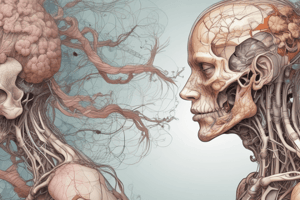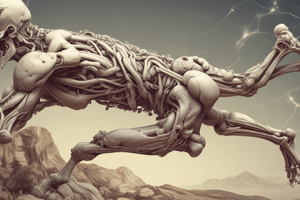Podcast
Questions and Answers
What does the term 'anatomy' primarily refer to?
What does the term 'anatomy' primarily refer to?
- The study of the effects of diseases on body organs
- The study of how body parts function
- The study of human physiology in different environments
- The study of body shape and structure (correct)
Which level of structural organization is defined as a group of similar cells that perform a common function?
Which level of structural organization is defined as a group of similar cells that perform a common function?
- Organ system
- Tissue (correct)
- Atom
- Organ
How do anatomy and physiology relate to one another?
How do anatomy and physiology relate to one another?
- Structure determines function. (correct)
- Anatomy is a subset of physiology.
- Physiology can exist without anatomy.
- They are entirely separate fields of study.
Which of the following is an example of gross anatomy?
Which of the following is an example of gross anatomy?
What is the correct order of structural organization from simplest to most complex?
What is the correct order of structural organization from simplest to most complex?
What role do molecules play in the structure of the body?
What role do molecules play in the structure of the body?
Which of the following best describes 'physiology'?
Which of the following best describes 'physiology'?
What term refers to a group of organs that work together to accomplish a common purpose?
What term refers to a group of organs that work together to accomplish a common purpose?
What is primarily responsible for regulating reproduction in the body?
What is primarily responsible for regulating reproduction in the body?
How does growth typically occur in the body?
How does growth typically occur in the body?
What is the typical stable body temperature maintained by homeostasis?
What is the typical stable body temperature maintained by homeostasis?
Which component of homeostasis is responsible for sending information to the control center?
Which component of homeostasis is responsible for sending information to the control center?
What percentage of air is oxygen, which is vital for chemical reactions in the body?
What percentage of air is oxygen, which is vital for chemical reactions in the body?
Which of the following is not considered a survival need for maintaining life?
Which of the following is not considered a survival need for maintaining life?
What maintains the dynamic state of equilibrium in homeostasis?
What maintains the dynamic state of equilibrium in homeostasis?
What is the role of the effector in the homeostatic control system?
What is the role of the effector in the homeostatic control system?
What is the primary purpose of maintaining boundaries in living organisms?
What is the primary purpose of maintaining boundaries in living organisms?
Which function is associated with the ability to sense changes in the environment?
Which function is associated with the ability to sense changes in the environment?
What role does metabolism play within the human body?
What role does metabolism play within the human body?
Which of the following is NOT one of the necessary life functions humans must perform?
Which of the following is NOT one of the necessary life functions humans must perform?
Which necessary life function involves movement at both the muscular and organ level?
Which necessary life function involves movement at both the muscular and organ level?
What is the primary outcome of the digestion process?
What is the primary outcome of the digestion process?
Which function includes the removal of wastes from the body?
Which function includes the removal of wastes from the body?
Which of the following is a component of movement in living organisms?
Which of the following is a component of movement in living organisms?
What is the primary role of negative feedback mechanisms in the body?
What is the primary role of negative feedback mechanisms in the body?
Which of the following is an example of a positive feedback mechanism?
Which of the following is an example of a positive feedback mechanism?
What can result from a homeostatic imbalance related to iodine deficiency?
What can result from a homeostatic imbalance related to iodine deficiency?
In which anatomical position is the body described?
In which anatomical position is the body described?
How do body planes help in anatomical terminology?
How do body planes help in anatomical terminology?
Which of the following correctly describes the sagittal plane?
Which of the following correctly describes the sagittal plane?
What is the main reason positive feedback mechanisms are infrequent in the body?
What is the main reason positive feedback mechanisms are infrequent in the body?
Which plane would be used to divide the body into superior and inferior parts?
Which plane would be used to divide the body into superior and inferior parts?
What structure is located within the nasal cavity?
What structure is located within the nasal cavity?
Which body cavity is primarily associated with hearing?
Which body cavity is primarily associated with hearing?
How many quadrants does the abdominopelvic cavity divide into?
How many quadrants does the abdominopelvic cavity divide into?
What is the primary purpose of the oral cavity?
What is the primary purpose of the oral cavity?
Which term refers to the areas defined within the abdomen by anatomists?
Which term refers to the areas defined within the abdomen by anatomists?
What does the term 'orbital cavities' refer to?
What does the term 'orbital cavities' refer to?
Which body cavity is part of the digestive system?
Which body cavity is part of the digestive system?
What distinguishes the abdominopelvic regions from the quadrants?
What distinguishes the abdominopelvic regions from the quadrants?
Flashcards are hidden until you start studying
Study Notes
Overview of Anatomy and Physiology
- Anatomy derives from Greek, meaning "to cut apart," focusing on body structure and relationships.
- Physiology studies how body parts function and work together.
- Gross anatomy involves large structures, while microscopic anatomy examines cells and tissues not visible without a microscope.
- Structure (anatomy) influences function (physiology); for example, lung structure allows for efficient gas exchange.
Levels of Structural Organization
- Organization of the human body spans from atoms to organisms.
- Atoms combine to form molecules (e.g., water, proteins).
- Cells are the smallest units of life, varying in size and shape based on their specific functions.
- Tissues consist of groups of similar cells with a common function.
- Organs are structures made of two or more tissue types, serving specific functions.
- Organ systems are groups of organs working together, forming the complete organism.
Maintaining Life
- Human life relies on eight necessary functions:
- Maintaining boundaries to separate internal and external environments.
- Movement consists of locomotion and internal transportation of substances.
- Responsiveness denotes the ability to react to environmental changes.
- Digestion involves breaking down food into absorbable molecules.
- Metabolism encompasses all chemical processes, including energy production via ATP.
- Excretion is the removal of waste from the body.
- Reproduction can occur at cellular and organismal levels.
- Growth indicates an increase in size or number of cells.
- Five survival needs include nutrients, oxygen, water, appropriate temperature, and atmospheric pressure.
Homeostasis
- Homeostasis maintains stable internal conditions despite environmental changes.
- It involves feedback systems:
- Negative feedback reduces stimulus intensity (e.g., blood pressure regulation).
- Positive feedback amplifies responses until a specific event occurs (e.g., childbirth).
- Homeostatic imbalances may lead to diseases, such as goiters from iodine deficiency or diabetes.
The Language of Anatomy
- Anatomical terminology ensures clarity in describing positions, directions, regions, and structures.
- The anatomical position features an erect body, arms at sides, with palms facing forward.
- Body planes include:
- Sagittal: divides the body into right and left.
- Frontal (coronal): divides anterior and posterior.
- Transverse: divides superior and inferior.
- Body cavities are classified into major categories, housing vital organs, such as:
- Oral and digestive cavities, responsible for food intake and digestion.
- Nasal cavity, part of the respiratory system.
- Orbital cavities, protecting the eyes.
- Middle ear cavities, containing bones for sound transmission.
Abdominopelvic Cavity
- The abdominopelvic cavity can be divided into quadrants or regions for detailed anatomical study.
- Understanding these regions assists in diagnosing conditions based on symptom location.
Studying That Suits You
Use AI to generate personalized quizzes and flashcards to suit your learning preferences.





